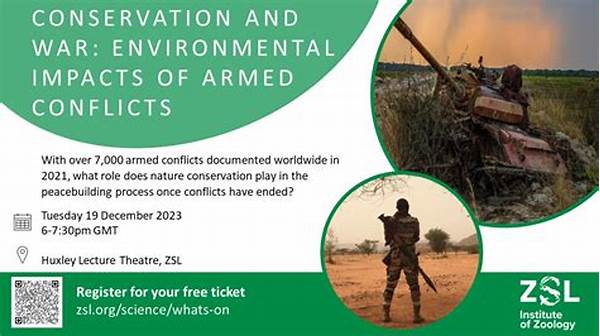The environmental impacts of armed conflict are a subject of increasing concern as the global community becomes more aware of their multifaceted repercussions. Conflicts often result in significant harm to ecosystems and biodiversity, which can have prolonged effects on human health and development. The direct and indirect consequences of military operations, coupled with the socio-economic upheaval they cause, lead to extensive degradation of the environment. Understanding these impacts is essential for creating effective policies for conflict resolution and post-conflict recovery, as well as for advancing global environmental sustainability.
Ecological Devastation and Loss of Biodiversity
In the context of armed conflict, environmental impacts manifest through various pathways, affecting ecological balance and biodiversity. Military actions, such as the deployment of heavy weaponry, result in land degradation and pollution. The destruction of forests, wetlands, and other critical habitats disrupts local ecosystems and threatens the survival of numerous species. Additionally, the movement of troops and equipment often leads to the trampling of vegetation and the compaction of soil, which further exacerbates the loss of biodiversity. The long-term consequences of these actions are profound and necessitate comprehensive strategies for environmental rehabilitation and conservation in post-conflict areas.
Furthermore, conflicts frequently lead to the displacement of human populations, which indirectly contributes to environmental degradation. As displaced individuals seek refuge, there is increased pressure on resources in specific areas, leading to over-exploitation and habitat destruction. Consequently, the armed conflict environmental impacts extend beyond immediate geographical zones of warfare, affecting regions that accommodate displaced populations. Addressing these challenges requires coordinated international efforts to support post-conflict environmental recovery and sustainable development initiatives.
Pollution and Resource Depletion
1. Armed conflict environmental impacts are evident in the form of chemical pollution, which results from the use of explosives and military equipment. Contaminants seep into soil and water bodies, posing long-term risks to ecological health and human populations reliant on these resources.
2. The extraction and misuse of natural resources often escalate during conflicts, leading to deforestation, overfishing, and depletion of water supplies. Such activities exacerbate the armed conflict environmental impacts, reducing ecosystems’ resilience and ability to recover post-conflict.
3. Air pollution also forms a substantial component of the armed conflict environmental impacts. The combustion of fuels in military vehicles and the detonation of explosives release pollutants that degrade air quality, posing threats to both local environmental conditions and human health.
4. Armed conflicts disrupt crucial environmental monitoring and management systems. This breakdown hampers efforts to address and mitigate the armed conflict environmental impacts, leading to prolonged ecological and human suffering.
5. The loss of agricultural productivity is another consequence of the armed conflict environmental impacts. Landmines and unexploded ordnance render large tracts of fertile land unusable for farming, undermining food security and long-term economic stability.
Social and Economic Consequences
The soldierly engagements involved in armed conflicts often lead to severe social and economic consequences tied directly to environmental degradation. Crucially, the environmental devastation impairs agricultural productivity, affecting food security and livelihoods. As fertile land becomes uninhabitable due to contamination and destruction, communities face food shortages and heightened malnutrition rates. This situation escalates the risk of prolonged periods of starvation and economic instability.
Moreover, the armed conflict environmental impacts result in the destabilization of local economies heavily reliant on natural resources. Fishing industries, forestry, and tourism often bear the brunt of environmental degradation caused by conflict. As resources deplete and natural beauty is destroyed, economic activities suffer, leading to increased poverty levels and societal unrest. Building resilient communities post-conflict necessitates targeted investment in environmental restoration programs that foster economic regeneration and sustainable growth.
Case Studies of Armed Conflict Environmental Impacts
A review of historical case studies illuminates the pervasive nature of armed conflict environmental impacts. The Gulf War of the early 1990s, for instance, saw the deliberate release of oil into the Persian Gulf, leading to widespread marine life devastation. Similarly, in the Vietnam War, the extensive use of herbicides such as Agent Orange resulted in significant deforestation, leaving a lasting legacy of biodiversity loss and health issues for future generations.
In the Democratic Republic of the Congo, ongoing conflicts have resulted in severe deforestation and the illegal exploitation of mineral resources. Such activities not only degrade the environment but also fund ongoing military engagements, creating a vicious cycle of armed conflict environmental impacts. These examples underscore the necessity for international cooperation and rigorous implementation of environmental protection protocols in conflict zones to mitigate these devastating impacts.
Remediation and Recovery Efforts
Addressing the armed conflict environmental impacts requires concerted efforts towards remediation and recovery. The preliminary step involves comprehensive environmental assessments to gauge the extent of damage and identify priority areas for intervention. International organizations, in collaboration with local entities, play a critical role in channeling resources and expertise towards rehabilitation projects.
Resilience building through reforestation, soil restoration, and water purification initiatives is imperative for revitalizing ecosystems and supporting biodiversity. Additionally, incorporating environmental considerations into peace-building frameworks is essential to ensure sustainable socio-economic recovery. Strengthening institutional capacities and fostering community involvement in resource management further facilitates effective recovery and paves the way for lasting peace and stability in post-conflict societies.
Conclusion
In summary, the armed conflict environmental impacts present multifaceted challenges that require urgent attention and action. The intricate links between military activities and ecological degradation highlight the importance of integrating environmental considerations into conflict prevention and resolution strategies. Failure to address these impacts not only jeopardizes ecosystem integrity but also exacerbates humanitarian crises and undermines peace-building efforts.
Sustainable recovery from the ravaging effects of armed conflict necessitates a paradigm shift towards policies that prioritize environmental protection and conservation. Through global cooperation and commitment to environmental stewardship, the international community can mitigate the adverse impacts and foster resilient, peaceful societies. The collective responsibility to safeguard our environment, even amidst conflict, remains paramount for current and future generations.





